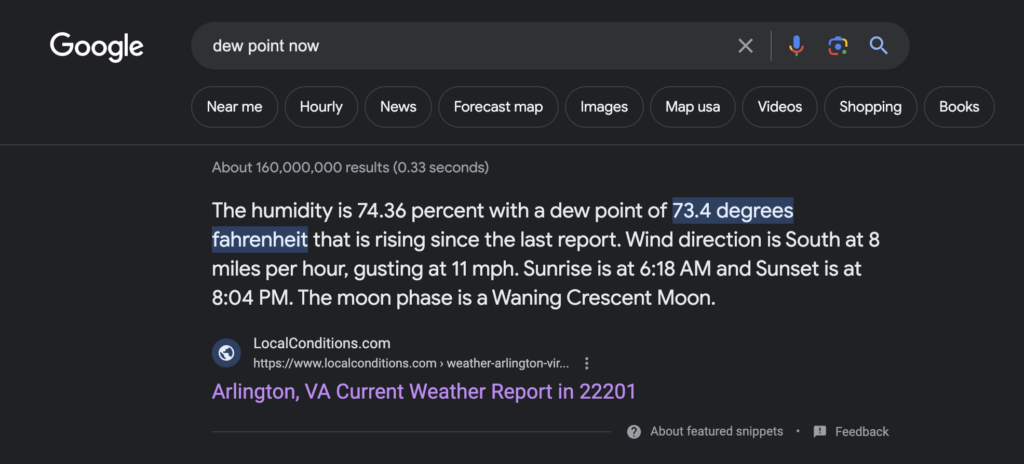A quick rule of thumb is that the closer the dew point is to the temperature of the air, the more likely the air will feel humid. However, the air temperature will affect your perception of humidity, so you may not always feel uncomfortable.
This handy table shows what dew point temperatures will likely make you uncomfortable:
| Dew point | How it feels |
| 40° | Nice summer day |
| 50° | Comfortable |
| 60° | Uncomfortable |
| 75° | Unbearable |
That’s it, nice and simple. But the question is, ‘Why?‘
Why am I talking about dew point when you clicked on an article about humidity? Shouldn’t I be writing about relative humidity levels?
Your confusion is totally justified, given that relative humidity is the metric that weather reporters use to forecast rain, fog, frost and what temperature will “feel like“.
To understand the table above, you need to learn more about the relationship between air, water and temperature, and how this relationship affects our experience of humidity.
Understanding the relationship between air, water and temperature
When the air is hot, it expands and rises. When the air is cold, it gets denser (contracts) and sinks. This change in temperature affects the air’s ability to hold water vapor.
Air can hold twice the amount of water vapor at higher temperatures (say 70°F or 21°C) than at lower temperatures (say 50°F or 10°C).
This is where the term relative humidity comes into play. Relative humidity quantifies the amount of water vapor present in the air compared to the maximum amount that the air can hold at the same temperature.
When relative humidity reaches 100%, that means that the air is holding as much water as it can at the current temperature. When this happens, the air becomes saturated with water.
Now, here is where temperature can make a big difference:
- When saturated air warms up, it can hold more water, which makes relative humidity drop — that’s the reason why your dryer uses warm air to absorb moisture in your clothes.
- When saturated air cools down, condensation happens as the air forces water out because it can’t hold it anymore — that’s the reason why your glass of cold iced tea leaves water rings on the table, as the moisture from the air condenses on the sides of the glass and this ‘sweat’ drips down to the table.
That’s where the term dew point comes in.
The dew point is the temperature at which the amount of water vapor in the air exceeds the amount of water vapor the air can hold. This is the point when water starts condensing and forming dew on surfaces below this cooler temperature threshold. It’s worth clarifying that in cases where the dew point is below freezing (32°F or 0°C), the water vapor turns directly into frost (frost point).
The connection between relative humidity (RH) and dew point
You may be used to seeing humidity described as ‘relative humidity’ (RH) in weather reports, but very little is said about ‘dew point’.
Say you watch the weather report for your area, and the reporter says that the RH today will be 50%, but once you leave your house, you are hit with a front of muggy air and within minutes, you feel yourself sweating. The next morning, the forecast says RH will be at 100%, so you head out wearing a t-shirt — because 50% more humidity would surely mean you will be sweating buckets, right? — but when you reach the porch, you realize you’re going to need a coat.
How could this be?
Well, RH is relative to the temperature of the air. What we’re missing from that scenario is what the temperature of the air was on those days.
Relative humidity could be 100% on a day when the temperature is at 86ºF (30ºC) and also on a day with 14ºF (-10ºC). But the reality is that no matter what the RH is at such a low temperature, it’s doubtful that you’ll be sweating and the air will feel muggy. However, if the temperature is 86ºF (30ºC) and the RH is at 60%, it will likely feel humid when the dew point sits at 70ºF (21ºC).
But why do some dew points feel more uncomfortable than others?
At higher dew points, the air around you becomes packed with water vapor, leaving little room for anything else. This inhibits the evaporation of sweat, making it impossible for your body to cool down.
At lower dew points, the lack of humidity in the air can cause skin irritation and cracking. It can also dry out your airways, which can be linked to the spread of certain viruses (such as cold, flu and even COVID-19) because the hair-like organelles outside of cell membranes become less effective at expelling viral particles.
Something to keep in mind is that humidity perception varies from person to person. People who were born in warmer climates (where higher dew points are the norm) will be more comfortable on ‘muggy days’ than those who were born in colder climates.
According to the Environmental Protection Agency, indoor relative humidity (RH) should be kept below 60% — ideally between 30% and 50%.
But as you know, humidity doesn’t function in isolation. Temperature is another important thing to consider.
Remember that at higher temperatures, the air can hold more moisture, which means that keeping your house nice and warm will help control the moisture levels in the air before condensation starts. This, in turn, will help avoid issues such as mold growth and other water-based damages.
Final thoughts
We believe the dew point is the best indicator of how you will feel regarding humidity. If the dew point is high, it will be muggier, and you’ll feel more uncomfortable. RH here is defunct when figuring out how humid the outside air is.
When Googling, try searching for “dew point now” to see the current dew point in your location:

The top hit will likely be https://www.accuweather.com, which has a handy chart telling you the dew point. Alternatively, you could use the dew point calculator found at http://www.dpcalc.org to calculate the dew point yourself based on the weather forecast for the day (you just need to enter the temperature and the RH percentage).
Lastly, if you have issues with either excess moisture or the opposite in your home, consider investing in a dehumidifier or humidifier. These tools can help you to regulate your home’s humidity levels.
SOURCES
- Ashton, D. (2023). What does mold smell like? housefresh.com
- Environmental Protection Agency. (n.d.). Why and Where Mold Grows. epa.gov
- Haby, J. (n.d.). Frost point and dew point. weather.gov
- JPL Science. (n.d.). Understanding climate. sealevel.jpl.nasa.gov
- National Weather Service. (n.d.). A Discussion of Water Vapor, Humidity, and Dewpoint, and Relationship to Precipitation. weather.gov
- Rochester Institute of Technology. (n.d.). Dew Point Calculator. dpcalc.org
- Sandoiu, A. (2020). How humidity may affect COVID-19 outcome. medicalnewstoday.com
- Wikipedia. Apparent temperature. wikipedia.org
- Wikipedia. Dew Point wikipedia.org
- Wikipedia. Humidity wikipedia.org







